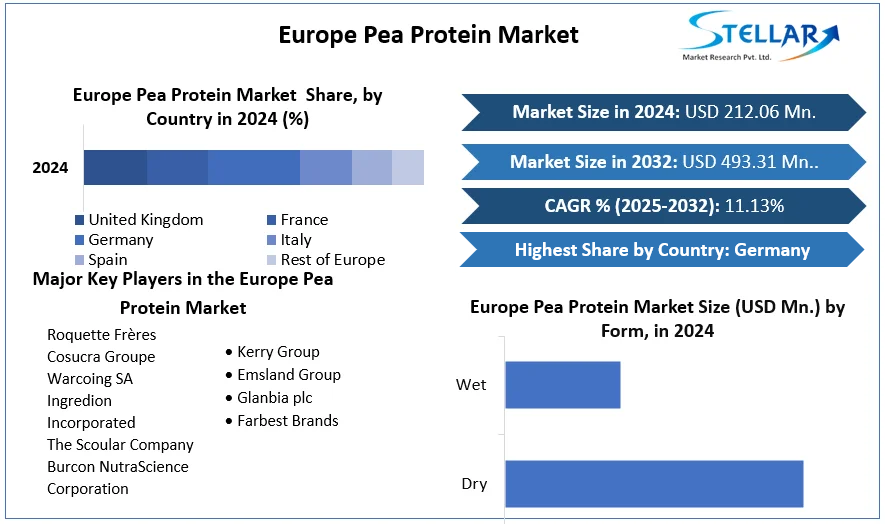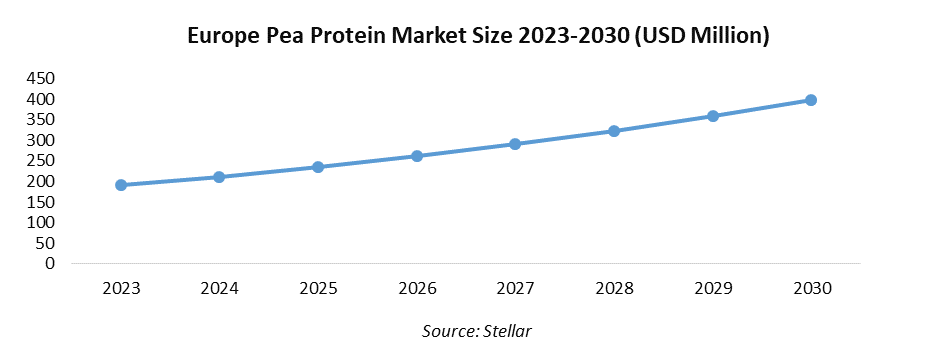Europe Pea Protein Market- Industry Analysis and Forecast (2025-2032)
Europe Pea Protein Market size was valued at USD 212.06 Mn. in 2024 and the total Market revenue is expected to grow at a CAGR of 11.13% from 2025 to 2032, reaching nearly USD 493.31 Mn.
Format : PDF | Report ID : SMR_1803
Europe Pea Protein Market Overview
Pea protein is a plant-based high-quality protein, rich in branched-chain amino acids, and easily available, cost-effective protein. Its well-balanced amino acid composition makes it a suitable preference among researchers. It has low allergenicity, higher digestibility, and lesser health controversy compared to soy protein. A mature pea on a dry basis, is comprised of 26% protein (of which 16-24% albumin and 50-55% globulin fraction).
The analysis offers crucial insights into the current European pea Protein market and unravels emerging trends and possibilities. The report consists of various factors propelling the market growth of Europe. The analysis of the countries which hold the majority of the market share in Europe. The report focused on current trends and developments in the Pea Protein market.
The utilization of pea protein has been a growing trend in the Europe food industry thanks to its diverse industrial applications, including its emulsifying, gelling, binding, and film-forming ability. In keeping with emerging consumer trends, the food industry is searching for protein ingredients to replace other plant and animal-based proteins. Pea protein has experienced significant growth as it is easily available, cost-effective, and has high nutritional value. In addition, it has excellent functional qualities, is gluten-free, and is a non-genetically modified organism. Pea protein is an excellent ingredient for improving the nutritional and technological properties of cereal and bakery products, meat and dairy products, and beverages. Compared to other plant proteins, pea protein as a food ingredient has some limitations in terms of its functionality, flavor, and color.

To get more Insights: Request Free Sample Report
Europe Pea Protein Market Dynamics
Emergence of Pea Protein Market In Europe
The increased demand for plant-derived proteins has gained prime importance thanks to the higher ethical profile, increasing concern from animal welfare organizations for meat proteins, and increased exposure to animal-based protein greenhouse emissions has propelled the market growth in Europe. Surged in the Pea protein market as it possesses various health benefits including antioxidative, antihypertensive, anti-inflammatory, cholesterol-lowering, modulating gut microbiota activity, etc. has accelerated the market growth. Pea proteins are emerging and preferred as a crucial choice among manufacturers as compared to other proteins.
The growing demand for plant-based food and the subsequent increase in plant-based alternatives across numerous categories has boosted the Pea Protein Market. Pea protein is a relatively new kind of plant protein as it has sufficient availability, cost-effectiveness, nutritional value, and significant health benefits, it is more popular in the food industry. Continuous research and development conducted to improve protein functionality, reduce undesirable color and flavor compounds, and improve the process to limit the damage to protein has influenced the market growth in Europe. The surge in pea protein manufacturers in Europe has led to the market growth of the country.

Challenges Facing Europe's Pea Protein Market
Surged demand for Pea Protein has led to a shortage of supply of pea protein in Europe. The cost of the pea protein is higher as compared to the other protein which has restrained the market growth. Customers of specific plant-based products tend to be satisfied, due to limited plant-based options available in retail locations in almost every food category. Pea protein is often more expensive to produce than alternative protein sources, leading manufacturers to charge higher prices to customers. Pea Protein has a distinct taste that is not appealing to every individual as a result formulating it according to customer preference has created a barrier for many manufacturers to produce the pea protein. The Diversity of plant-based markets such as soy, rice, and hemp proteins has hindered the market growth in the European region. The extraction and processing of pea protein has been complex and involves the use of specific technologies. Challenges in processing have affected the overall cost and quality of pea protein.
Europe Pea Protein Market Segmentation Analysis
Based On Product, the Protein Isolate segment holds the highest market share of 75% with a growing CAGR of 12.10% during the forecast period. The occurrence of lifestyle-related health problems such as diabetes, allergies, and obesity has driven a shift towards vegetarian meals. The increase in demand for pea protein isolate in Europe owing to the it exhibits various properties such as emulsification, foaming, and water binding capacity The low purity pea protein isolate of 75% -80% has dominated the European pea Protein Market in 2024. Europe has experienced significant growth in the pea protein isolate market owing to the higher consumption of diets that contain high proteins.
The majority of the production of pea protein isolate is produced in Europe thanks to the availability of yellow pea which is used to produce pea protein isolate. Pea Protein isolate is known for its sustainability as it is considered environmentally friendly compared to traditional proteins which are produced from animal-based products. Pea Protein Isolate is rich in amino acids resulting in market growth in the region.
Europe Pea Protein Market Regional Analysis
Germany holds the highest share of 32.80 % Pea Protein Market with a growing CAGR of 11.20%. Pea protein is used in pharmaceutical applications, edible film coating material, extruded products, food emulsifiers, food supplements, etc. According to Stellar Analysis, In 2024, Germany was the leading source of searches about veganism, followed by Austria and the UK. In metropolitan areas, consumers are choosing healthy food options such as natural and organic foods. Increased awareness of non-GMO and chemical-free foods is influencing the growth of naturally sourced protein powder in the global market. France is the fastest-growing country with a share of 15.10% with a CAGR of 10.50% during the forecast period.
The European Consumer Survey on Plant-based Foods found that the UK's purchase and consumption rates of plant milk, meat alternatives, vegan margarine, vegan cheese, vegan ready meals/food to go and seafood alternatives are the highest in Europe. Italy, Spain, Belgium, and Australia emerge as a promising market for the Europe pea protein industry and are driven by rising disposable income and heightened health awareness. In Sweden, a developing market with a substantial population, the European pea protein market is in its early stages, holding growth potential Europe Pea Protein Market Competitive Analysis
- In 2023, Roquette has extended its Nutralys plant protein portfolio by adding four multi-functional pea proteins for plant-based foods and high-protein nutritional products.
- In November 2022, Royal DSM introduced Vertis CanolaPRO, a premium canola protein isolate. According to the company, this innovative product elevates the protein content of plant-based foods and beverages while remaining free from major allergens. When incorporated into a protein blending strategy, Vertis CanolaPRO synergizes effectively with legume and cereal proteins, addressing gaps in essential amino acids.
|
Europe Pea Protein Market Scope |
|
|
Market Size in 2024 |
USD 212.06 Mn. |
|
Market Size in 2032 |
USD 493.31 Mn. |
|
CAGR (2025-2032) |
11.13% |
|
Historic Data |
2019-2024 |
|
Base Year |
2024 |
|
Forecast Period |
2025-2032 |
|
Segment Scope
|
By Product
|
|
By Form
|
|
|
By Source
|
|
|
By Application
|
|
|
Country Scope |
|
Europe Pea Protein Market Key Players
- Roquette Frères
- Cosucra Groupe Warcoing SA
- Ingredion Incorporated
- The Scoular Company
- Burcon NutraScience Corporation
- Kerry Group
- Emsland Group
- Glanbia plc
- Farbest Brands
Country Breakdown:
France Pea Protein Market: Industry Analysis and Forecast (2024-2030)
United Kingdom Pea Protein Market: Industry Analysis and Forecast (2024-2030)
Germany Pea Protein Market: Industry Analysis and Forecast (2024-2030)
Frequently Asked Questions
Supply Chain disruptions are expected to be the major restraining factors for the market growth.
Germany is expected to lead the Europe Pea Protein market during the forecast period.
The Market size was valued at USD 212.06 Million in 2024 and the total Market revenue is expected to grow at a CAGR of 11.13% from 2025 to 2032, reaching nearly USD 493.31 Million.
The segments covered in the market report are By Product, Form, Source, and Application.
1. Europe Pea Protein Market: Research Methodology
1.1. Research Data
1.1.1. Secondary Data
1.1.2. Primary Data
1.2. Market Size Estimation
1.2.1. Bottom-Up Approach
1.2.2. Top-Down Approach
1.3. Market Breakdown and Data Triangulation
1.4. Research Assumption
2. Europe Pea Protein Market: Executive Summary
2.1. Market Overview
2.2. Market Size (2024) and Forecast (2025 – 2032) and Y-O-Y%
2.3. Market Size (USD) and Market Share (%) – By Segments
3. Europe Pea Protein Market: Competitive Landscape
3.1. SMR Competition Matrix
3.2. Key Players Benchmarking
3.2.1. Company Name
3.2.2. Headquarter
3.2.3. Product Segment
3.2.4. End-user Segment
3.2.5. Y-O-Y%
3.2.6. Revenue (2024)
3.2.7. Profit Margin
3.2.8. Market Share
3.2.9. Company Locations
3.3. Market Structure
3.3.1. Market Leaders
3.3.2. Market Followers
3.3.3. Emerging Players
3.4. Consolidation of the Market
4. Europe Pea Protein Market: Dynamics
4.1. Europe Pea Protein Market Trends
4.2. Europe Pea Protein Market Drivers
4.3. Europe Pea Protein Market Restraints
4.4. Europe Pea Protein Market Opportunities
4.5. Europe Pea Protein Market Challenges
4.6. PORTER’s Five Forces Analysis
4.7. PESTLE Analysis
4.8. Technological Roadmap
4.9. Value Chain Analysis
4.10. Regulatory Landscape
5. Europe Pea Protein Market: Market Size and Forecast by Segmentation (by Value in USD Million and Volume in Metric Tons) (2024-2032)
5.1. Europe Pea Protein Market Size and Forecast, by Product (2024-2032)
5.1.1. Protein Isolates
5.1.2. Protein Concentrates
5.1.3. Textured Pea Protein
5.2. Europe Pea Protein Market Size and Forecast, by Form (2024-2032)
5.2.1. Dry
5.2.2. Wet
5.3. Europe Pea Protein Market Size and Forecast, by Source (2024-2032)
5.3.1. Yellow split peas
5.3.2. Chickpeas
5.3.3. Lentils
5.4. Europe Pea Protein Market Size and Forecast, by Application (2024-2032)
5.4.1. Sports Nutrition
5.4.2. Meat Extenders and Substitutes
5.4.3. Nutritional Supplements
5.4.4. Beverage
5.4.5. Snacks
5.5. Europe Pea Protein Market Size and Forecast, by Country (2024-2032)
5.5.1. Germany
5.5.2. United Kingdom
5.5.3. Spain
5.5.4. France
5.5.5. Italy
5.5.6. Belgium
5.5.7. Sweden
5.5.8. Poland
5.5.9. Russia
6. Company Profile: Key Players
6.1. Roquette Frères
6.1.1. Company Overview
6.1.2. Business Portfolio
6.1.3. Financial Overview
6.1.4. SWOT Analysis
6.1.5. Strategic Analysis
6.1.6. Recent Developments
6.2. Cosucra Groupe Warcoing SA
6.3. Ingredion Incorporated
6.4. The Scoular Company
6.5. Burcon NutraScience Corporation
6.6. Kerry Group
6.7. Emsland Group
6.8. Glanbia plc
6.9. Farbest Brands
7. Key Findings
8. Analyst Recommendations
8.1. Strategic Recommendations
8.2. Future Outlook
















